
I found this on the bathroom wall at Richters Olstue, a restaurant in Køge built in 1644.
In Part 2: CASUAL JAUNTS THRU SWEDEN and DENMARK, we walked for miles on cobbled streets, rode a ferry to Drottningholm to see the Queen’s Castle and the oldest opera house in the country, and discovered that five days is simply not enough to cover the 89 museums located in Stockholm, Sweden.
Things you should know about Denmark, routinely recognized as one of the happiest countries on earth. Even Danes struggle to articulate words spoken with mostly vowels.
What they call hot dogs sold at small kiosks, Americans would call sausages.
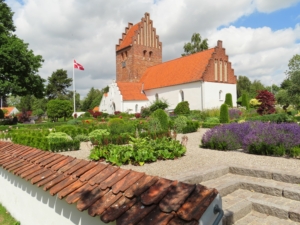
The church where Erik and Else were married was begun in the 1100s.
Danes are not religious but join (mostly Lutheran) churches because that’s where you are married and buried.
Taxes are high but no one has to do without health care.
Danes are fiercely supportive of their athletes. How else to explain that more than one million Danes in a population of 5.8 million watched every grueling televised minute of the 2023 Tour de France until 26-year-old Jonas Vingegaard, wearing his lucky neon yellow jersey, won for the second consecutive time? And speaking of bicycles, don’t even think of walking in front of a parade of bicycles traversing the city streets. Even automobiles don’t challenge that pedaling barrage of enthusiasts.
Children’s birthday cakes are shaped like a man or woman and covered in marzipan, icing, candy, and lots and lots of licorice. Danes also eat a lot of herring. Thanks, but I’ll stick with the cake.
You can pocket your cash because since the pandemic, only credit cards are used. Climate change has struck with a wave of heat (anything approaching 75 F), which would be fine except few buildings and residences have air conditioning. Like neighboring Sweden, most Danes speak English (as well as other languages) fluently, love American music, and value their history and cultural distinctions.
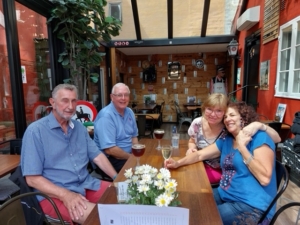
Russ and I with dear Danish friends Erik and Else, enjoying food, fun and each other’s company.
If you read Part 1 of my story (and if not, why not?), you will understand that my husband Russ and I were in Denmark to visit our Danish friends Else and Erik Kaaber (and their extended loving family) for the third time. We first spent days in Sweden being guided by Else’s lifetime friend, Sven Grützmeier (a Dane who became a Swedish citizen and now lives in Stockholm).
Else and I met my senior year of high school when she was an exchange student. Their system of education is ordered differently than in the U.S. This was not her senior year chronologically, but academically, she was ahead. I was the editor of the school newspaper and she the proofreader. Her impeccable English meant she was better suited to the task than others on the staff. We lost touch and years later reconnected through a FaceBook classmates’ page. She and Erik have come to Orlando (FL) and we have since visited them.
This trip was purposely planned to be more leisurely than our previous two trips when they had guided us to popular tourist attractions, such the Tivoli Gardens (built in 1843 and said to have inspired Walt Disney to create EPCOT) and Rosenborg Castle Gardens. Their meticulously prepared detailed daily list of tourist places to still see, including Russ’ one request to see the national train station museum, still left us time to hang out together more leisurely.
After our frustrating train trip from Stockholm, Sweden to Copenhagen Central Station that took hours longer than anticipated (see part 1), and frantic What’s App phone calls trying to describe where we were located in the station, the Kaabers found us (to everyone’s tired relief!). By the time we battled rush hour traffic and arrived at our hotel, Comwell Køge Strand, we were all hungry and too tired to have dinner anywhere but in the hotel restaurant, a just-okay barbeque meal that surprised us because every single veggie salad was bathed in mayonnaise. The bottle of wine was about six times the cost it would have been in the U.S, so our $20 bottle cost nearly $100.

Cows roam between the Comwell Køge Strand and the beach.
Comwell Køge Strand is a 127-room conference hotel, with fields of grass and cows between the hotel and the beach. A 5–10-minute walk on one of several paths leads to the water. Our first floor “garden” room had a small patio surrounded by a waist-high fence. The hotel has no air conditioning. The room was stuffy and stank, especially upon first entering. We wondered if an allowable pet had used the carpet as a toilet. We bought fans to circulate the air and opened the patio door when inside. We informed the front desk staff many times over the next days of an unbearable odor in the room. Housekeepers were tasked with spraying and re-vacuuming. Nothing worked until a week later when the drains were cleaned out.
The room was simply furnished but overdue for a complete makeover. The toilet room was separate from the bath/shower room, with one small trash can total. Unbeknownst to us, guests are expected to sort their trash and place it in outside hallway bins. Linens would be changed every three days, but fresh towels could be requested daily. Danish hotels do not offer washcloths. The shower wall had an attached bottle of shampoo to thicken hair but no conditioner or shower gel. There was no soap on either bathroom sink. Thank goodness I bring small soaps. I also pack my own toiletries because I am sensitive to most provided ingredients. Russ knew to bring disposable washcloths.
During our nine-night stay, the several breakfast rooms were always crowded, yet there was just one coffee machine in the hall. The line extended down the staircase to the lobby most of the time. The machine coffee was watery and tasteless, even after adding a shot of espresso. Yet, the kitchen staff were to be celebrated for their cheery demeanor and efficiency. After several days of seeing one lead server, Lene, I politely asked if there was any way of getting stronger coffee. She was gone for the next couple days but upon her return, Russ and I had a pot of stronger coffee waiting for us each day after. She also labeled a pot of cream for his coffee. Every server knew to fetch that pot for him.
The breakfast buffet had a variety of choices that never varied. There were scrambled eggs sitting in a small glass ramekin with a tiny piece of bacon and a three-bite piece of sausage sitting atop what was a warming plate, but Russ tried the eggs and said they weren’t even lukewarm. There was hummus, falafel, breads, two homemade jams, varieties of juices, loads of fruits, and several types of deli meats and cheeses. Although there were several rooms in which to sit, including a sunroom and a room overlooking greenery, all were enclosed in glass with no air conditioning or window to open. Denmark gets about 17 hours of sunlight in early July, so even early morning sun that poured in the glass windows made sitting in those rooms less than comfortable.
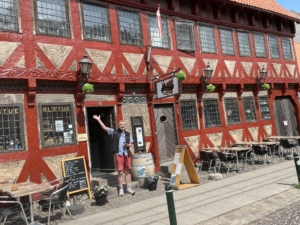
Erik waves from the outside of Richters Olstue, buiilt in 1644 in Køge.
The last night in Denmark, the four of us packed it in early. Russ wanted a sweet dessert and a glass of wine before heading to our room. It was too far to walk into town and nothing else was near. The restaurant’s evening hostess said we would have to buy an entire meal to get a dessert. The lounge bar only had small jars of nuts to buy. We had brought our own supply of nuts to snack upon so ended up going back to our room and eating those.
WHERE WE ATE MEMORABLE MEALS:
Tip 1: In Sweden, a 10% max tip on any bill may be left, but even that is only if you want. In Denmark, staff is paid well enough that no tip is expected.
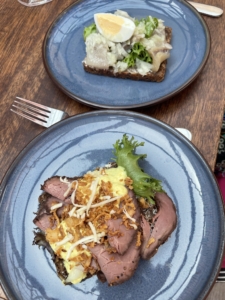
Traditional Danish open-faced sandwiches from Richters Olstue cafe.
Richters Olstue, a small café in the seaport city of Køge, was built in 1644. It was just the casual, homey atmosphere we wanted, and the traditional open-faced sandwiches were exactly what we needed. I chose roast beef with remoulade, fried onions, and horseradish. Another typical Danish sandwich has boiled potato, bacon, mayo, and raw onion. The men had their first Royal Classic beer, a dark lager favored by Erik (and quickly also by Russ).
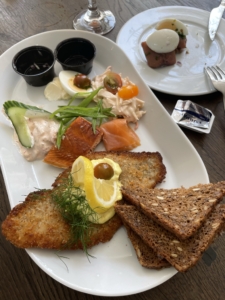
Erik’s fish platter at Restaurant Sommers.
On our drive to Praesto (Priest Island), we stopped at Restaurant Sommers, across the street from the waterfront. This place was as cute as could be with fresh purple, lime and pink dyed willow wisps in a small glass upon each table and in large floor vases. Oversized windows offered views of boats moored in the quiet water. The brief walk we took through the quaint compact village streets lined by close-together buildings from the reformation age were just as welcoming. Red and pink hollyhocks front the colorfully wooded half-timber houses with pitched roofs.
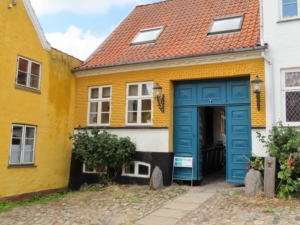
Hollyhocks huddle close to colorful wooded half-timber houses in Praesto (Priest Island).
At the restaurant, the men indulged in their favorite Royal Classic lager, the second largest beer producer in Denmark. The largest producer is Carlsberg. The lager apparently complimented the hand-formed juicy cheeseburger with Bearnaise-infused mayo that Russ later said was the best burger he has had in Denmark (and he’s eaten many). Erik had a fish platter that contained herring, salmon, and hardboiled egg slices. Else and I both chose a Caesar salad with crispy chicken pieces and a few tomatoes. I had a glass of cabaret sauvignon that didn’t detract from the salad.
Tip 2: Caesar salads in Denmark always have ingredients you wouldn’t expect from an American menu, or the salad would be labeled something else. The Danish version may contain bacon chunks, little if any Parmesan cheese, and the dressing doesn’t resemble anything like any Caesar dressing I’ve had. That doesn’t mean the salads aren’t fresh or tasty. I had several during our visit and each was quite good.
Tip 3: Parking is a very serious matter in Denmark. On a trip to Field’s Shopping Mall, one of the largest in Denmark, Erik was fined for not properly registering the car after parking, thinking that the license plate had been photographed at the entrance as has been done at another parking garage. He feared having his tires hit the parking space lines, which would merit a fine, so kept adjusting the car until firmly within the space. Another day we wanted to visit a Sand Sculpture show (see below) and eat at Molen Restaurant (Dog Place), located next door to the marina. The meter for the parking lot abutting the restaurant was broken and a guard chased us away. We drove across the marina to a wide-open parking lot. Saw security passing out lots of tickets and didn’t understand why, so we parked in another section and hoped for the best.
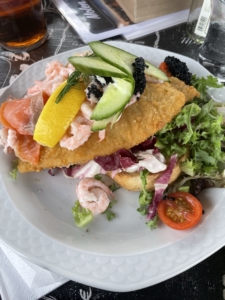
My Falling Star traditional meal at Molen Restaurant.
We still wanted to eat at Molen because Erik and Else had eaten there and attested to the quality. The men enjoyed their dark lager beer and I had a glass of fruity pinot grigio to balance my traditional Danish meal called Falling Star. This meal consisted of two large fried fish filets topped with mounds of small shrimp, cold-smoked salmon, several angled slices of cucumber, remoulade, and a local caviar sided by wild greens, all atop toast.
Tip 4: Bubbly alcohol and alcohol like Jägermeister is available for breakfast in hotel breakfast buffets. The belief is that a shot of bitters stimulates the body (much in the way strong coffee does to me).
American music from the 50s through the 70s plays at most restaurants we visited, but music is not the only influence America has had on Denmark. For instance, Halloween-styled trick or treating is becoming more popular with young children.
For Else’s outdoor birthday celebration with 18 friends and family, she had American barbecue ribs and sides catered by Bones, a 50-60s’s styled restaurant in Køge that plays Elvis and the Beatles in jukeboxes and has pictures of Tbirds and beefed-up motorcycles hanging from the walls. The strong breeze threatened to blow down the backyard open-styled tent top but I stayed cozy wrapped in one of Else’s knitted shawl creations.
Another night we ate at Stacy’s Diner Køge, a 50’s diner you’d have expected to find the Pink Ladies hanging out in on a Friday night. Car license plates decorated the walls. I fully expected the costumed waitresses to be wearing roller skates even though we sat indoors. The restaurant, both indoors and outside, was jammed with families, teens, and groups of adults. The burgers were gigantic and juicy, and options included every topping imaginable, including of course, Bearnaise. A heaping pile of French fries accompanied the burgers. Milk shakes and malts were options we didn’t choose, but I contentedly grooved in my booth bench while listening to the music that sang the story of my life.
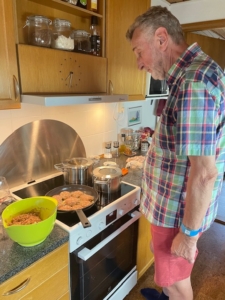
Erik prepared his “famous frikadeller”, a traditional Danish meatball.
I would be remiss if I talk about memorable meals without mentioning the night Erik prepared his “famous frikadeller”, a traditional Danish meatball. I can’t reveal the recipe or the process because this is a family secret. What I can disclose is that more than one meat is involved and the meatballs are flattened slightly and fried during part of the process. That evening, our meal also included new potatoes, cooked carrots, a large everything-is-in-it salad, and of course, some terrific wine.
In Part 4: CASUAL JAUNTS THRU SWEDEN and DENMARK, we stroll limestone quarries, become agog at the costume and photography exhibit at Geomuseum Faxe, discover a king’s obsession with pipes, and Russ and Erik get their groove on at the Danish Railway Museum. And that’s before we were astounded by the prolific contributions by Danes highlighted at the Danish Architecture Center.
www.comwell.com/hoteller/comwell-hotel-koege-strand
www./richters-lstue.business.site
www. stacysdiner.dk
Karen Kuzsel is a writer-editor based in the Orlando area who specializes in the hospitality, entertainment, meetings & events industries. She is an active member of International Live Events Association and Meeting Professionals International and is now serving on the 2022-2023 MPI Global Advisory Board for Small Business Owners. She is a member of the Society of Professional Journalists. Karen writes about food & wine, spas, destinations, venues, meetings & events in her blog, Hotel Happenings & Program Promotions. A career journalist, she has owned magazines, written for newspapers, trade publications, radio and TV. As her alter-ego, Natasha, The Psychic Lady, she is a featured entertainer for corporate and social events. Karen@KarenKuzsel.com; www.KarenKuzsel.com; www.ThePsychicLady.com; @karenkuzsel; @thepsychiclady. She is also active with Experience Kissimmee CVB and Wedding Venue Map. Food photos for this series by Karen Kuzsel. All other photos by Russ Wagner, a retired government planner/builder who has a passion for historic architecture, wine, trains, travel and taking photographs.
